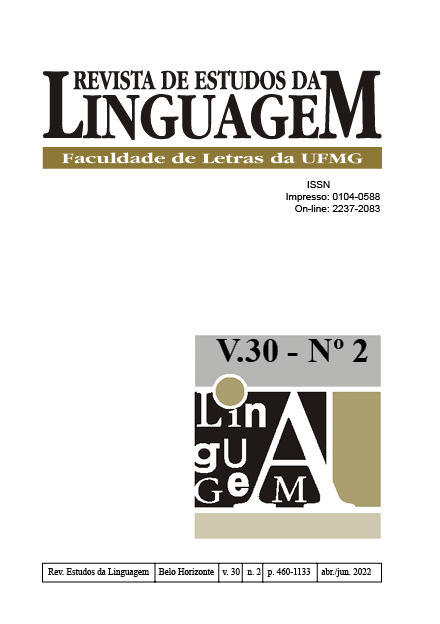Mapeamento de padrões construcionais com o verbo virar na língua portuguesa
DOI:
https://doi.org/10.17851/2237-2083.30.2.545-572Palavras-chave:
verbo, construção, língua portuguesaResumo
O objetivo deste artigo foi analisar os usos com o verbo virar a fim de mapear um conjunto de padrões construcionais associado a ele na Língua Portuguesa. Com este fim, o estudo filiou-se aos Modelos Baseados no Uso e, mais especificamente, à Abordagem Construcionista Baseada no Uso (GOLDBERG, 2019), assumindo a construção – pareamento de forma e de significado – como a unidade básica de análise. Para o desenvolvimento da pesquisa, adotou-se o Método Misto Incorporado em que foram empregados diferentes procedimentos para análise qualitativa e quantitativa dos dados. O Corpus do Português foi o banco de dados utilizado e foram coletadas 922 ocorrências que são provenientes dos séculos XIX e XX. A hipótese era que as Construções de Estrutura Argumental interferissem no agrupamento de representações associado ao verbo na mesma medida em que os verbos interferem na representação das Construções de Estrutura Argumental. A análise confirmou a hipótese ao constatar usos do verbo virar com a Construção de Movimento Causado, a Construção de Movimento Intransitiva, a Construção Resultativa Intransitiva, a Construção [Pronome Oblíquo + virar] e a Construção [virar e mexer + Oração]. Desse modo, o agrupamento de representações atribuído ao verbo também inclui seus diferentes contextos de uso que assumem diferentes padrões oracionais e, a partir deles, usos mais específicos emergem. Assim, o artigo contribui com discussões sobre a natureza do significado verbal pela Gramática de Construções.





